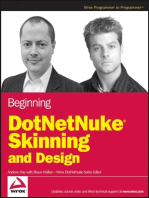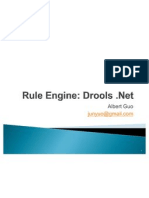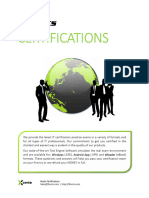Dotnet Syllabus
Uploaded by
kkumar_876069Dotnet Syllabus
Uploaded by
kkumar_876069.
NET SYLLABUS
Introduction of the Microsoft .NET Framework
y y y y y y
Introduction to the .NET Framework .NET Architecture Use the Visual studio IDE Common Type System / Common Language Specification / Common Language Runtime .NET Framework class library Garbage Collector
Programming Using C#
y y y y y y y y
Explain features of object oriented approach Identify and use operators including arithmetic,assignment,unary,comparison,and logical Use constructs and loop constructs Implement structures,enumerations,arrays,and collections Implement polymorphism and overload functions and operators,composition,utilization,and instantiation Explain and use delegates and events Use various stream classes to implement file handling Develop single and multi-threaded applications
Programming with VB.NET
y y y y y y
Creating Windows Forms Implementing OOPS in VB.Net Working with Form Controls Component & Interoperability User Controls & Custom Controls Exception Handling
GUI Application Using ASP.NET
y y y y y y
Creating Web Forms Using Server Controls Creating a Microsoft ASP.NET Web Form Crystal Reports Configuring, Optimizing, and Deploying a Microsoft ASP.NET Web Application Web Application Security Overview
Accessing Data with Microsoft ADO.NET
Introduction to SQL Server 2005
y y y y y y y y
Connecting to a Database Manage Databases, Tables and Data in Tables Implement Triggers and Stored Procedures Implement Joins,Constraints,Views Accessing Data with Data Sets Using Multiple Tables Accessing Data with Data Readers Accessing Data with Microsoft ADO.NET
Consuming and Creating Web Service
y y y y
COM+
Overview of Using Web Services Web Service Using HTTP Creating an Web Service Consuming and Creating Web Services
y y y y y y y y
Introduction Configuration Security Enterprise Applications State Management Resource Managers Components Events Debugging
SMART DEVICE APPLICATIONS
y y y y y y
Introduction combat Tools Data Access using SQLCE Data Access using SQL server Data Access Using Web services Smart Device essentials
Microsoft Visual Studio 2005 Support and New Features
y y
Changes in .Net Framework 2.0 in comparison with 1.1 Advanced .Net Framework 3.5
You might also like
- Full Download Agile Project Management With Azure DevOps: Concepts, Templates, and Metrics 1st Edition Joachim Rossberg PDF83% (6)Full Download Agile Project Management With Azure DevOps: Concepts, Templates, and Metrics 1st Edition Joachim Rossberg PDF62 pages
- Microsoft SQL Azure Enterprise Application DevelopmentFrom EverandMicrosoft SQL Azure Enterprise Application DevelopmentNo ratings yet
- Microsoft Exambible ms-720 Exam Dumps 2022-Dec-01 by Fitzgerald 73q VceNo ratings yetMicrosoft Exambible ms-720 Exam Dumps 2022-Dec-01 by Fitzgerald 73q Vce17 pages
- 29R. Innovative+AI+Test+Automation+ToolsNo ratings yet29R. Innovative+AI+Test+Automation+Tools9 pages
- Ultimate AWS Certified Cloud Practitioner’s Exam Guide: Master the Concepts, Services, Security, and Architectural Best Practices of AWS, EC2, S3, and RDS, and Crack AWS CLF-C02 Certification (English Edition)From EverandUltimate AWS Certified Cloud Practitioner’s Exam Guide: Master the Concepts, Services, Security, and Architectural Best Practices of AWS, EC2, S3, and RDS, and Crack AWS CLF-C02 Certification (English Edition)No ratings yet
- Actualpdf: Unlimited Lifetime Access To 5000+ Certification Actual Exams PDFNo ratings yetActualpdf: Unlimited Lifetime Access To 5000+ Certification Actual Exams PDF28 pages
- Cloud Computing: Post Graduate Program inNo ratings yetCloud Computing: Post Graduate Program in20 pages
- How To Build An Agile Release in 15 MinutesNo ratings yetHow To Build An Agile Release in 15 Minutes10 pages
- Silo - Tips - Ac2324 Auckland Council Producer Statement Authors Register Page 1 of September 2016 Ac2324No ratings yetSilo - Tips - Ac2324 Auckland Council Producer Statement Authors Register Page 1 of September 2016 Ac232468 pages
- A Visually Rich Overview of The Scrum Framework: Ken Rubin, Innolution100% (1)A Visually Rich Overview of The Scrum Framework: Ken Rubin, Innolution36 pages
- Selenium with C#: Learn how to write effective test scripts for web applications using Selenium with C# (English Edition)From EverandSelenium with C#: Learn how to write effective test scripts for web applications using Selenium with C# (English Edition)No ratings yet
- 8 Agile Estimation Techniques To Try With Your Team - Parabol100% (1)8 Agile Estimation Techniques To Try With Your Team - Parabol23 pages
- Mohamed Ahmed Meligy Senior Software Engineer Silverkey Technologies, LLCNo ratings yetMohamed Ahmed Meligy Senior Software Engineer Silverkey Technologies, LLC36 pages
- Immediate download PgMP Practice Test Questions 1000 Practice Exam Questions for the PgMP Examination 1st Edition Ginger Levin Pmp Pgmp ebooks 2024100% (1)Immediate download PgMP Practice Test Questions 1000 Practice Exam Questions for the PgMP Examination 1st Edition Ginger Levin Pmp Pgmp ebooks 202465 pages
- Hallo Blazor: Building Modern Full-Stack Web Apps with .NET 9.0From EverandHallo Blazor: Building Modern Full-Stack Web Apps with .NET 9.0No ratings yet
- Case Study Based On: Cloud Deployment and Service Delivery ModelsNo ratings yetCase Study Based On: Cloud Deployment and Service Delivery Models10 pages
- Advanced Software Engineering Lecture 04No ratings yetAdvanced Software Engineering Lecture 0439 pages
- PgMP Exam Practice Test and Study Guide Third Edition Ward 2024 scribd download100% (1)PgMP Exam Practice Test and Study Guide Third Edition Ward 2024 scribd download91 pages
- 02 C# Coding Questions For Technical Interviews - Ankit Sharma's BlogNo ratings yet02 C# Coding Questions For Technical Interviews - Ankit Sharma's Blog21 pages
- Advanced Topic - What's New in SAFe 5.0 - Scaled Agile FrameworkNo ratings yetAdvanced Topic - What's New in SAFe 5.0 - Scaled Agile Framework1 page
- Professional Cloud DevOps Engineer - enNo ratings yetProfessional Cloud DevOps Engineer - en33 pages



























































